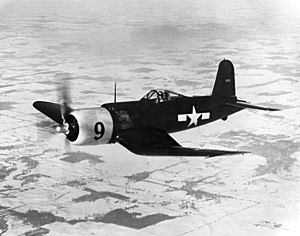|
Goodyear F2G Corsair
The Goodyear F2G Corsair, often referred to as the "Super Corsair", is a development by the Goodyear Aircraft Company of the Vought F4U Corsair fighter aircraft. The F2G was intended as a low-altitude interceptor and was equipped with a 28-cylinder, four-row Pratt & Whitney R-4360 air-cooled radial engine. Such a fighter was first conceived in 1939, when Pratt & Whitney first proposed the immense, 3,000 hp (2,200 kW) R-4360,[1] and design work began in early 1944. Design and development
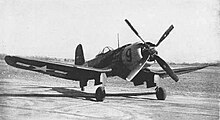 Using experience gained building the F4U-1 under license – a variant known as the FG-1 – in early 1944, Goodyear modified seven standard Corsair airframes to take advantage of the 50% increase in take-off power provided by the Pratt and Whitney R-4360 engine. Known as the XF2G-1,[N 1] these aircraft also featured a new all-round vision bubble-type canopy in place of the original cockpit and turtle deck.[2] A land-based variant, with manually-folding wings, was to be known as the F2G-1, while a carrier version with hydraulically-folding wings and arrestor hook was to be called the F2G-2.[3] In March 1944, Goodyear was awarded a contract to deliver 418 F2G-1 and 10 F2G-2 aircraft. The vertical stabilizer's height was also increased by 12 inches, and an auxiliary rudder was added to counteract engine torque.[4] With all these design modifications, the rate of climb of the F2G was increased to 7,000 feet per minute, which was double that of a standard Corsair and higher than jet fighters in service at that time. The aircraft was intended to be operated from land bases as opposed to aircraft carriers. The F2G-1 had manually folding wings and no tail hook, allowing for reduced weight. The F2G-2 had hydraulically powered wing fold mechanisms and tail hooks installed to allow for carrier operations. Armament was to include four or six wing-mounted 0.5-inch (12.7 mm) machine guns and eight 5-inch (127 mm) rockets or two 1,000lbs (454kg) Mk.83 GP bombs or 1,600lbs (725kg) AN-Mk.1 armor piercing bombs. The internal fuel capacity of the F2G was increased greatly over that of the F4U, and provisions were also made for two droptanks. However, post-production testing revealed deficiencies in lateral control and insufficient speed, which were bars to further development of the design. In addition, the Grumman F8F Bearcat – a rival design that had also entered production – had performance comparable to the F2G, even though it was powered with the same engine as the original F4U. By the end of the war in August 1945, when only 10 aircraft (five examples of each variant) had been completed, further production of the F2G was canceled. VariantsXF2G-1: prototype. Seven converted from standard FG-1 Corsairs.[2][N 2] F2G-1: land-based variant, 418 ordered, five built, order cancelled. F2G-2: carrier-based variant, 10 ordered, five built, order cancelled. OperatorsAccidents and incidents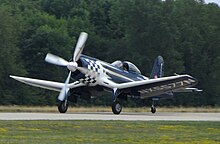 On 7 September 2012, the heavily modified F2G-2 "Race 74", BuNo 88463 and registered N5577N, was destroyed in a fatal crash that occurred when pilot Bob Odegaard was rehearsing for an airshow flight routine at the Barnes County Municipal Airport in Valley City, North Dakota.[5][6] Surviving aircraft Two Super Corsairs have survived into preservation, with one airworthy.
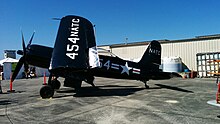
Specifications (F2G-2)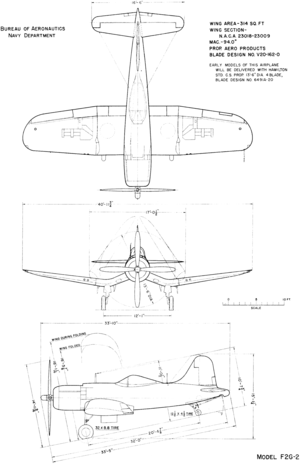 Data from [citation needed] General characteristics
Performance
Armament
See alsoRelated development Aircraft of comparable role, configuration, and era
Related lists
ReferencesNotes
Citations
Bibliography
External linksWikimedia Commons has media related to Goodyear F2G Corsair. |
||||||||||||||||||||||||||||
